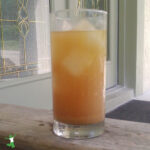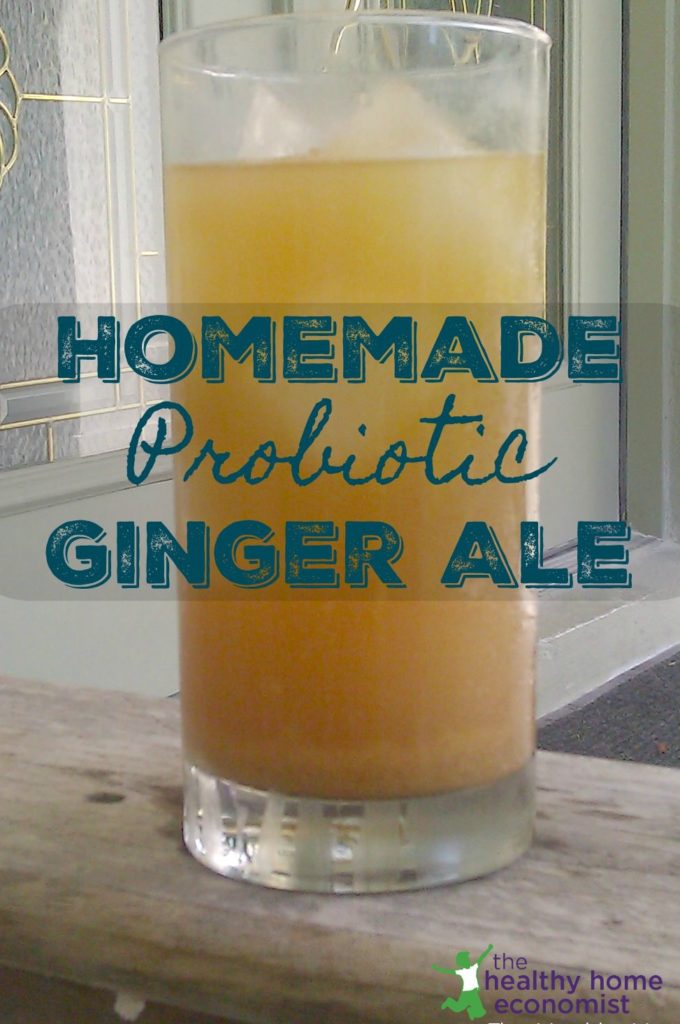Table of Contents[Hide][Show]
A traditional recipe for homemade ginger ale that is lightly fermented with cultured starter, which adds beneficial probiotics and enzymes for digestive benefits as well as delicious taste!

Ginger ale is one of the easiest drinks to whip up at home in a matter of minutes.
The bonus of making ginger ale yourself is that you can ferment it.
This means it is loaded with beneficial bacteria known as probiotics. In addition, traditionally brewed ginger ale is rich in enzymes and has enhanced nutritional value.
Fermentation of grains, fruits and herbs into refreshing and delicious drinks is nearly universal in ethnic cuisines, according to the Nourishing Traditions cookbook, from which this beverage recipe is adapted.
Sadly, the emphasis on convenience in our modern society means that this practice is largely forgotten with the continued popularity of commercial sodas.
Modern versions of ancestral beverages offer no redeeming nutritional benefit.
Worse, the consumption of these sugar-laced or artificially sweetened drinks encourages obesity and other chronic ailments.
Soda really can be healthy! Learning traditional preparation techniques is all that is required.
Preparation Tips
Raw liquid whey is the suggested starter for this beverage and the one I’ve used for decades with great success.
Please refer to this article on the various methods for making raw whey at home for additional details to determine which approach works best for you.
Note that you cannot buy raw whey commercially, although some small dairy farms have it available for purchase.
If a dairy allergy is present, a quarter cup of ginger ale starter or “ginger bug” or water kefir is a simple substitution.
Other ideas for dairy-free fermentation are detailed in the linked article.
While sucanat (pure dried cane juice) is the recommended sweetener, jaggery is a healthy option as well that produces great results.
Raw honey also works for those on gut healing diets such as GAPS. Note that the fermentation will generally occur a bit more quickly using it. I suggest reducing the fermentation time to 1-2 days if using raw honey.
A secondary fermentation using bottles to add additional fizz is optional, but a great idea if you have the time and inclination!

Homemade Ginger Ale Recipe
A traditional recipe for homemade ginger ale that is lightly fermented with cultured starter which adds beneficial probiotics and enzymes to the brew.
Ingredients
- 2 quarts filtered water
- 1/2 cup lime juice freshly squeezed, about 3 limes (preferably organic)
- 2 tsp ground ginger or 2 Tbsp freshly chopped ginger
- 1/3 cup sucanat
- 1 tsp sea salt
- 1/4 cup liquid whey do not use powdered whey
- 1-2 Tbsp raw honey optional
- pinch green stevia powder optional
Instructions
-
Mix all ingredients together thoroughly in a half gallon glass jar. Be sure to leave 1 inch at the top else the soda will get moldy instead of ferment. Affix a secure lid.
-
Leave at room temperature on the counter to culture for 2-3 days and then refrigerate. Homemade ginger ale is mildly fizzy. You can then mix with sparkling mineral water post-fermentation to add even more fizz if desired.
-
Alternatively, you can bottle the homemade soda and leave on the counter for an additional 1-2 days before refrigerating to produce a very fizzy beverage. Be sure to let the bottled soda get very cold before opening. Opening in the sink is a good idea.
-
If the finished homemade ginger ale is not sweet enough for your taste (usually necessary for those coming off a soda habit), add a pinch of optional stevia or stir in a small amount of raw honey.

Other Fermented Beverages to Try!








can you elaborate more on freezing limes or other citrus fruits. Do you just stick it in a freezer bag & then in the freezer? does this change the fruit in any way?
Just slice them in half and store in containers or freezer bags. They thaw and juice nicely.
How to Make Ginger Ale – The Healthy Home Economist http://t.co/1ReIndo
Hi Sarah- As a new subscriber via RSS, I knew I subscribed to you for a reason 😉
This sounds great and easy. Can’t wait to try it and have another excuse to use my cool new 1/2 gallon mason jars.
Where might I find organic ginger powder? Thanks, this looks wonderful and something I had been meaning to look up.
I buy mine from Frontier. Many healthfood stores carry it or contact Frontier for a Frontier buying club near you.
Will it still taste good if I trade out the fresh lime juice for fresh lemon?? Thanks!
It will taste a bit different but still great I’m sure.
Sarah and KC,
It is delicious with lemon! My husband says I can make this all the time.
This is a great site to follow.
If I wanted to use fresh ginger instead of the powdered ginger, how much would I use in the recipe?? Looking forward to trying it! Thanks!! 🙂
3/4 cup fresh ginger finely grated if you wish to go that route.
Would this be GAPS legal if you used only 1/4 c sugar and did the double ferment?
You couldn’t use sucanat as this is not allowed on GAPS. You would have to use raw honey but the flavor would turn out a bit different. Still would be nice though, I’m sure.
You’ve convinced me. I’m going to give it a try. Do you need to use tall 1/2 gallon jars? I have several half gallon glass jars from coconut oil. But they are fat, not narrow and tall like the canning 1/2 gallon jars. (same size around as gallon jars, but shorter.)
Sure, those would work fine.